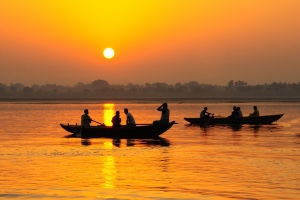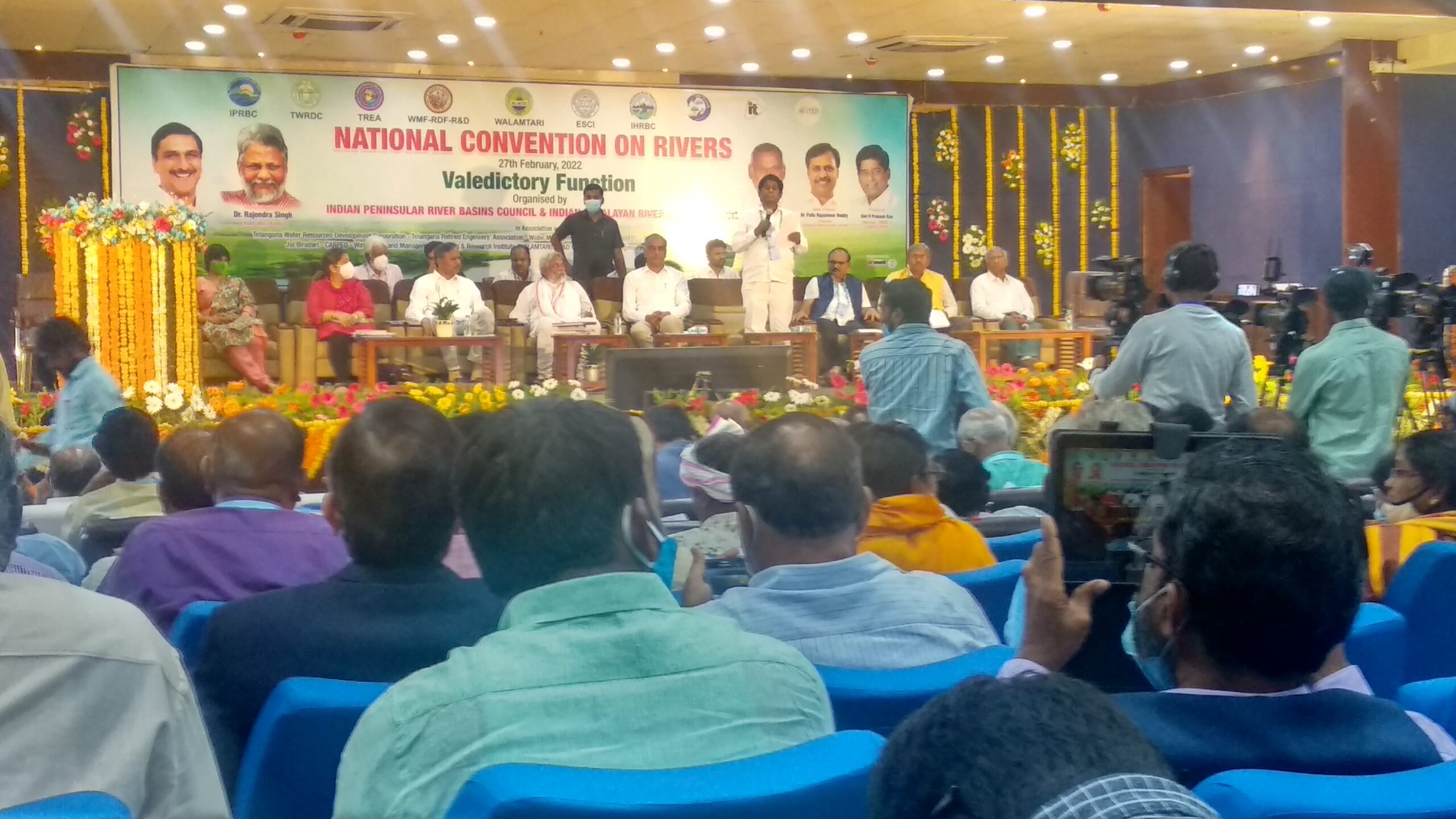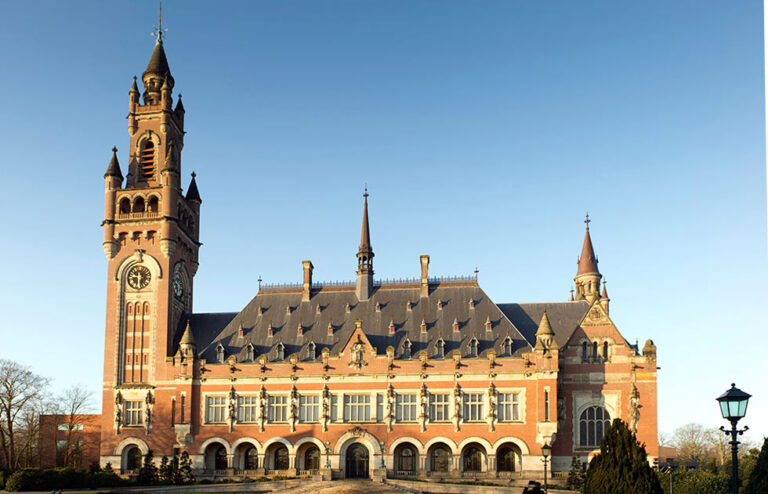
Hyderabad: India constitutes 18 per cent of the world’s population and 4 per cent of the world’s renewable water resources. There has been ever-growing pressure on water resources in view of changing rainfall patterns due to climate change, pollution of water bodies, exploitation of water resources and internal disputes between the riparian states. The stage of groundwater extraction in the country is 62 per cent.
To resolve these issues in a community-driven, decentralised structure, water activists organised a unique two-day national conclave here in which ministers of Telangana and Karnataka too represented their governments with constructive ideas to resolve pending issues and “work as a family in the spirit of being beyond cultural and political boundaries”.
Almost 1000 water activists, students, lawyers, politicians and bureaucrats from 27 states joined together in this unique conclave, representing the rivers in their regions. In the proceedings, through sharing and discussion and through questions and answer sessions, they resolved to make every river in India win the legal status of being an individual with rights.
“For this purpose, we will make a well researched Public Interest Litigation for which a team of experts and legal members will be created,” they said in a declaration at the end of the National Convention on Rivers Declaration.
The declaration stated: “We have disregarded the right of the river to have a healthy and pure continuous ecological flow. Our exploitation, encroachment and pollution of the river have been continued relentlessly. We shall strive to identify all rivers, tributaries and the people of these rivers who are active in protecting and healing them and we shall form the families, like Krishna River Basin Kutumb, which transcend the man-made borders which otherwise divide us and create rights-based conflicts instead of the responsibility based convergent approach to river and human health.”

Underscoring the need to understand how public health is dependent on the health of the river, the river activists stressed refining the human relationship with rivers and their catchment area. They also raised concerns over the commoditization of the river that they claimed was causing conflict between states and communities.
During the conclave, the activists started a consulting process to discuss the shape of a proposed ‘National River Manifesto’. “We have distributed the feedback form with outlines of the proposed content and purpose of the Manifesto. We have sought immediate feedback on this form as well as extended the time of feedback and suggestions up to 31st March 2022,” a joint declaration signed by Dr Rajendra Singh, popularly known as the Waterman of India, V.Prakash Rao, Chairman of Telangana Water Resources Development Corporation, among others, stated.
The primary purpose of the National River Manifesto, they said, was to call upon all the citizens of all river basins of India to revive and join together the action programmes to heal the ailing rivers. “Through seeking extensive feedback and merging the feedback-suggestions received we will co-author the River Basin Manifesto and become the family of co-creators of a common minimum river protection and river rejuvenation approach,” they stated. The declaration further added: “We shall thus become the Voice of our Voiceless Rivers.”
The participants hoped that this synergized expression of the people’s shall lead to the reform in the political will.
Earlier, a few months ago, the activists under the guidance of Dr Singh had also created two river basin councils – the Indian Peninsular River Basins Council (IPRBC), with V. Prakash Rao as its chairman, and the Indian Himalayan River Basins Council (IHRBC) with environmentalist Dr Indira Khurana as its chairman. During the conclave here that ended yesterday, they also decided that the core team members and coordinators of the different State River Councils, under IPRBS and IHRBC, will adopt a river and begin to implement the purpose stated in the declaration.
In order to thus protect and rejuvenate the rivers, the activists said they shall “robustly” pursue the creation of the National River Manifesto based on the detailed consultative process and that the draft manifesto would be further discussed on April 14 and 15, 2022. By that time every river basin team shall also adopt a river and begin work there, inclusive of research and response.
Some of the salient features of the proposed manifesto were already outlined during the conclave. They included:
- To evolve our River Basin Understanding individually and collectively
- To repair and to heal our individual and collective relationship of inter-dependence with the Mother River and the River Basin
- To weave a comprehensively inclusive people to people River Basin Wide grass-roots Networking through the adopting of rivers
- To institutionalise the regular interactions between civil society and governance institutions.
While emphasising on maintaining a spirit of friendliness and fellowship, the declaration underlined adhering to the following principles and action-imperatives to serve and to heal the Indian Rivers and each River Basin Ecology:
- The space of rivers belongs to rivers only and it must not be used as a commodity to establish infrastructural projects like roads etc under the pretext of development in the interest of society
- The sewer and industrial waste (solid & liquid) shall not be allowed to enter the river
- The environmental flow shall be decided and all activities for rights and responsibilities in each Peninsular River Basin shall respect the need to ensure that environmental flow.
- The ecology of each River Basin shall be restored.
- A robust dialogue on resolving river disputes will be initiated in the tradition of ’Family of the River ’ sitting together to reach a resolution of all issues.
– global bihari bureau






The heritage of the Ganga state passing through the only district of Jharkhand
Separate arrangements should be made for conservation, promotion and research
Friends, as everyone knows, the Ganges passes through Sahibganj, the only district of Jharkhand. In such a situation, Ganga is a heritage for our state. One of the two banks of the river touches about 83 km of Sahibganj district of Jharkhand. History is witness that human civilizations have developed on the banks of rivers. Sahibganj is the most backward district of the state and the country. Although Sahibganj is fortunate that this city is situated on one bank of the Ganges. From this our hope is tied that due to being situated on the banks of Ganga, the most backward district of the country will one day become a developed city. Although it is not that Sahibganj was as backward as it is today, but there was a time when Sahibganj was known as Mini Kolkata. But getting trapped in the political vicious circle, Sahibganj went backward. The people of this district situated on the banks of the Ganges are still hopeful that one day the wheel of time will spin and Sahibganj will once again be included in the developed districts. Maybe it has already started. Today a bridge is being built on the Ganges in Sahibganj. The Multi Modal Terminal has been constructed at Sahibganj. And this is a matter of concern for us. The progress towards development compels one to think that if the Ganga gets angry with Sahibganj, then once again the development of Sahibganj will stop. Rivers keep changing their form from the geographical point of view. Its effect has been seen in Sahibganj in the last several years. In fact, through Manihari Ghat of Katihar district of Bihar, the Ganges enters Sahibganj city, touching the area of Rampur Diara under Sadar block of Sahibganj district of Jharkhand. But the mouth of Rampur Diara got closed due to silt. Due to which the Ganga flowing towards the city started flowing through Rampur towards Sakrigali. In such a situation, about 10 km from the edge of the city, the Ganges created the Gokhur Lake. If the system of removing the silt had been made at that time, then this geographical change of the Ganges could have been prevented by artificial means.
The distance from Sahibganj to Farakka Barrage is approximately 83 kms. Whereas the Ganges passes by touching the banks of Sahibganj for about 83 km. In such a situation, an area of 84 km is sensitive to artificial barrier in the form of barrage. Siltation is highest in these areas. That is, we can say In such a situation, we demand that a separate department should be formed in Sahibganj to monitor every geographical change of the river, to maintain its ecosystem including its management, protection, conservation and research. Whose complete office setup should be in Sahibganj Headquarters. The silt should be cleaned at least two to three times a year to maintain the flow of Ganga in Sahibganj city. In the end, I would say that such a situation should not come that a city on the banks of the Ganges has to be deprived of the Ganges. If this happens, it will be no less than the death of that city. Because Ganga is the giver of life….Thank you
NSS volunteers and NCC cadets students and people should be apart of as गंगा मित्र गंगा प्रहरी
DR RANJIT Kumar Singh NSS programme officer cum Nodal officer
Sahibganj college Sahibganj
SKMU Dumka Jharkhand
Thank you dear Deepakji for sparing your valuable time to attend National Convention on Rivers and writing a note on River Manifesto..
Thanks for the coverage. It helps with the outreach, always.
Thanks, Deepak-bhai.